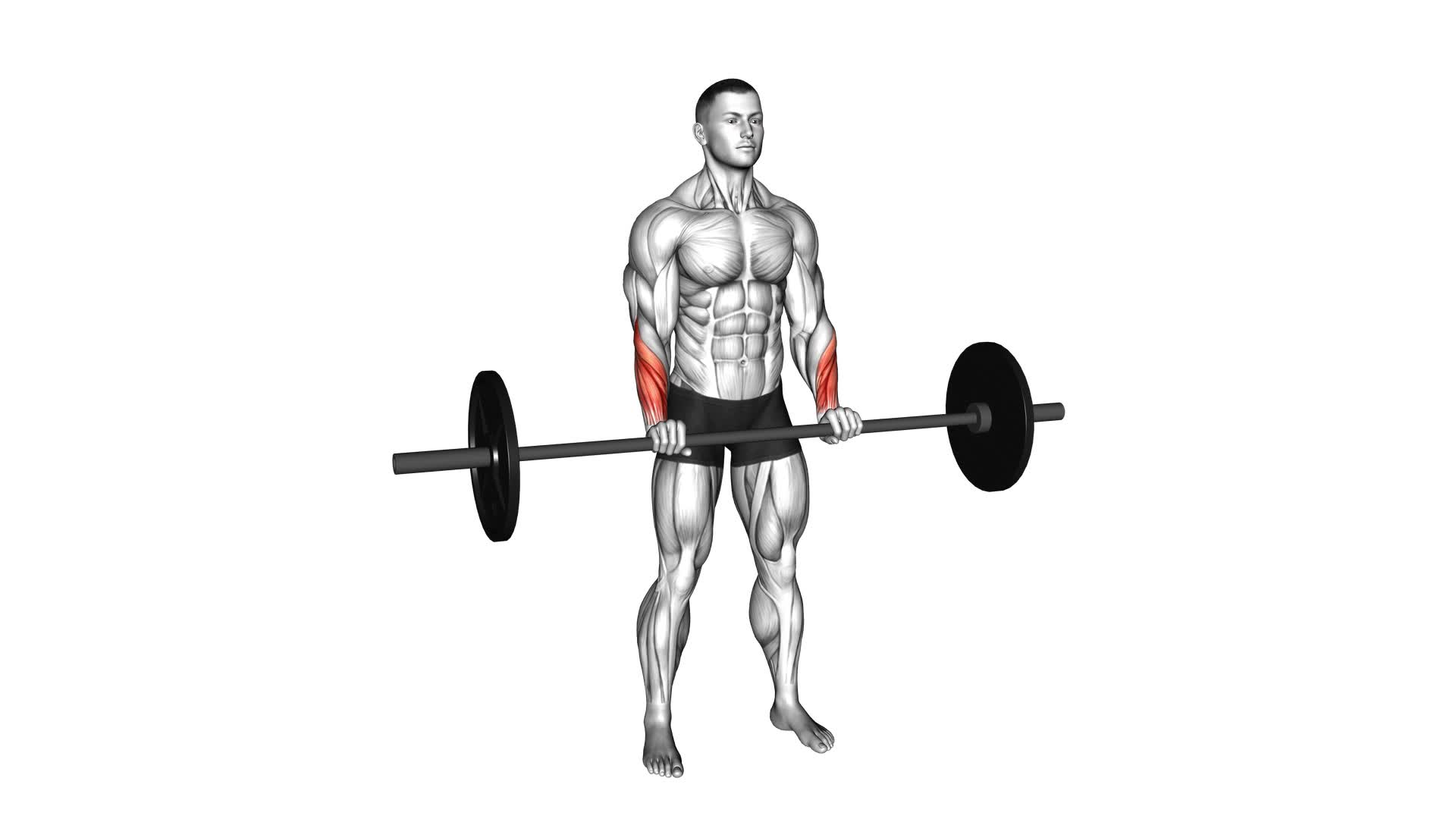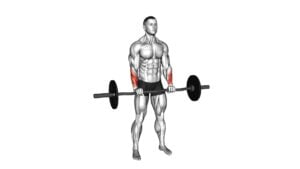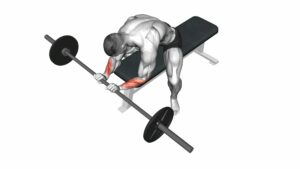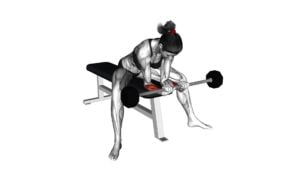Barbell Standing Wrist Reverse Curl – Video Exercise Guide & Tips

Looking to strengthen your wrists and forearms? The barbell standing wrist reverse curl is the exercise for you.
Watch This Exercise Video
In this video exercise guide, we'll show you the proper technique, common mistakes to avoid, and provide tips for increasing intensity.
Safety precautions and modifications will also be covered.
Get ready to improve your wrist strength and take your workouts to the next level with this effective exercise.
Let's dive in!
Key Takeaways
- Improved wrist strength and flexibility
- Targets forearm muscles and improves grip strength
- Enhances performance in weightlifting, rock climbing, and racquet sports
- Can be beneficial for athletes in various sports
Benefits of Barbell Standing Wrist Reverse Curl
You can experience improved wrist strength and flexibility with the benefits of performing the Barbell Standing Wrist Reverse Curl. This exercise is highly effective in targeting the forearm muscles and improving grip strength.
By incorporating the Barbell Standing Wrist Reverse Curl into your workout routine, you can build strong and resilient wrists that will enhance your performance in various activities, such as weightlifting, rock climbing, and racquet sports.
The Barbell Standing Wrist Reverse Curl specifically targets the extensor muscles of the forearm, which are responsible for wrist extension and grip strength. These muscles are often neglected in traditional strength training exercises, but they play a crucial role in maintaining overall upper body strength and function.
By regularly performing this exercise, you can strengthen the muscles that are involved in gripping and holding objects, allowing you to have a firmer and more secure grip. This can be particularly beneficial for athletes who rely on their grip strength, such as golfers, tennis players, and wrestlers.
In addition to improving grip strength, the Barbell Standing Wrist Reverse Curl also helps to enhance wrist flexibility. This is important for activities that require a wide range of motion in the wrists, such as yoga, gymnastics, and martial arts.
To learn the proper technique for the Barbell Standing Wrist Reverse Curl, continue reading the next section.
Proper Technique for Barbell Standing Wrist Reverse Curl
To perform the Barbell Standing Wrist Reverse Curl correctly, start by gripping the barbell with an overhand grip and standing with your feet shoulder-width apart. Keep your back straight and your core engaged throughout the exercise. Begin by extending your wrists so that the barbell is resting on the top of your thighs. This is the starting position.
From here, exhale and slowly lower the barbell by flexing your wrists, allowing it to roll down to your fingertips. Keep your forearms stationary and only move your wrists. Inhale and reverse the movement by curling your wrists back up, bringing the barbell back to the starting position. Repeat for the desired number of reps.
When performing the Barbell Standing Wrist Reverse Curl, there are a few common errors to watch out for. Avoid using momentum to lift the weight, as this takes away from the effectiveness of the exercise. It's also important to keep your elbows and upper arms stationary throughout the movement, focusing solely on the wrists.
Variations and modifications for the Barbell Standing Wrist Reverse Curl include using dumbbells instead of a barbell, or using an EZ bar for a different grip. Additionally, you can perform this exercise seated instead of standing to target the muscles in your forearms in a slightly different way.
Remember to start with a weight that allows you to maintain proper form and gradually increase the weight as you become stronger and more comfortable with the exercise.
Common Mistakes to Avoid During Barbell Standing Wrist Reverse Curl
What are some common mistakes to avoid during the Barbell Standing Wrist Reverse Curl? Here are some form tips to ensure you perform the exercise correctly:
- Using too much weight: One of the most common mistakes is using excessive weight that you can't control. Start with a lighter weight and gradually increase as you build strength and improve your form.
- Incorrect grip: Make sure to use an overhand grip with your palms facing down. Keep your wrists straight throughout the movement and avoid bending them.
- Swinging the barbell: Avoid using momentum or swinging your body to lift the weight. This not only reduces the effectiveness of the exercise but also puts unnecessary strain on your wrists.
- Rounding your back: Maintain proper posture throughout the exercise by keeping your back straight and core engaged. Avoid rounding your back or leaning forward, as this can lead to injuries.
Tips for Increasing Intensity and Progression in Barbell Standing Wrist Reverse Curl
To increase the intensity and progression in the Barbell Standing Wrist Reverse Curl, gradually increase the weight and challenge yourself with heavier loads as your strength and form improve. This will help you build muscle and continue to make progress in your workouts.
In addition to increasing the weight, you can also incorporate progression techniques and advanced variations to further challenge yourself. One technique is to perform the exercise with a slower tempo, focusing on the eccentric (lowering) phase of the movement. This will increase time under tension and stimulate muscle growth.
Another technique is to incorporate pauses at different points in the exercise, such as holding the weight at the top of the movement for a few seconds before lowering it back down. This will increase the difficulty and engage your muscles even more.
Advanced variations include using an EZ bar instead of a straight barbell or performing the exercise on an unstable surface like a balance board or BOSU ball. These variations will challenge your stability and core strength, providing an extra level of intensity to your workouts.
By incorporating these progression techniques and advanced variations, you can continue to challenge yourself and make progress in the Barbell Standing Wrist Reverse Curl. This will help you achieve your fitness goals and improve your overall strength and muscle definition.
As you increase the intensity of your workouts, it's important to also consider safety precautions and modifications for the Barbell Standing Wrist Reverse Curl.
Safety Precautions and Modifications for Barbell Standing Wrist Reverse Curl
As you progress in the Barbell Standing Wrist Reverse Curl, it's essential to prioritize safety and consider appropriate modifications to ensure proper form and prevent injury. Here are some safety precautions and modifications to keep in mind:
- Start with a lower weight: When performing the Barbell Standing Wrist Reverse Curl, it's crucial to begin with a weight that you can comfortably handle. Gradually increase the weight as your strength and form improve to avoid straining your wrists or other muscles.
- Maintain proper wrist alignment: To minimize the risk of injury, make sure to keep your wrists in a neutral position throughout the exercise. Avoid excessive flexion or extension, as this can put unnecessary strain on the joint.
- Use wrist wraps: If you have weak or sensitive wrists, consider using wrist wraps for added support and stability. Wraps can help prevent hyperextension and provide a more secure grip on the barbell.
- Alternative exercises: If you experience discomfort or pain during the Barbell Standing Wrist Reverse Curl, it may be necessary to modify or choose an alternative exercise. Some alternatives include dumbbell wrist curls or using resistance bands to target the same muscle groups without putting excessive strain on the wrists.
Frequently Asked Questions
How Many Sets and Reps Should I Do for the Barbell Standing Wrist Reverse Curl?
For the barbell standing wrist reverse curl, the number of sets and reps can vary depending on your goals and fitness level. It's recommended to start with 3-4 sets of 8-12 reps. However, you can also try different rep and set ranges to challenge your muscles and promote growth.
Incorporating this exercise into your routine can improve grip strength, forearm muscles, and overall upper body strength.
Can I Use Dumbbells Instead of a Barbell for This Exercise?
Yes, you can use dumbbells as an alternative to a barbell for the standing wrist reverse curl. The exercise targets your forearm muscles and helps improve grip strength.
Using dumbbells allows for a greater range of motion and can provide a different stimulus to your muscles. However, it may be more challenging to maintain proper form and control with dumbbells.
It's always important to start with lighter weights and gradually increase as you gain strength and confidence.
What Other Exercises Can I Include in My Workout Routine to Target the Same Muscles as the Barbell Standing Wrist Reverse Curl?
To target the same muscles as the barbell standing wrist reverse curl, you can include exercises like dumbbell wrist curls, hammer curls, and reverse curls in your workout routine.
These exercises specifically target the muscles of the forearms and wrists, helping to strengthen and build muscle in those areas.
Are There Any Variations or Modifications to the Barbell Standing Wrist Reverse Curl That I Can Try?
There are several variations and modifications you can try for the barbell standing wrist reverse curl. These can help add variety to your workout and target the same muscles in different ways.
Some options include using dumbbells instead of a barbell, performing the exercise on an incline bench, or using resistance bands.
These variations can provide different levels of intensity and challenge to your wrist and forearm muscles.
Can I Perform the Barbell Standing Wrist Reverse Curl if I Have Wrist or Forearm Injuries?
If you have wrist or forearm injuries, it isn't recommended to perform the barbell standing wrist reverse curl. These exercises put strain on those areas and could worsen your condition.
However, there are alternative exercises you can try that target the same muscles without putting as much stress on your wrists and forearms.
It's important to consult with a medical professional or a certified trainer to find the best injury modifications and alternative exercises for your specific situation.
Conclusion
In conclusion, the barbell standing wrist reverse curl is a beneficial exercise for strengthening and toning the wrists and forearms. By following proper technique and avoiding common mistakes, you can maximize the effectiveness of this exercise.
Additionally, incorporating tips for increasing intensity and progression will help you continue to challenge your muscles. Remember to prioritize safety by using appropriate modifications and listening to your body.
Incorporate this exercise into your routine for improved wrist and forearm strength.

Author
Years ago, the spark of my life’s passion ignited in my mind the moment I stepped into the local gym for the first time. The inaugural bead of perspiration, the initial endeavor, the very first surge of endorphins, and a sense of pride that washed over me post-workout marked the beginning of my deep-seated interest in strength sports, fitness, and sports nutrition. This very curiosity blossomed rapidly into a profound fascination, propelling me to earn a Master’s degree in Physical Education from the Academy of Physical Education in Krakow, followed by a Sports Manager diploma from the Jagiellonian University. My journey of growth led me to gain more specialized qualifications, such as being a certified personal trainer with a focus on sports dietetics, a lifeguard, and an instructor for wellness and corrective gymnastics. Theoretical knowledge paired seamlessly with practical experience, reinforcing my belief that the transformation of individuals under my guidance was also a reflection of my personal growth. This belief holds true even today. Each day, I strive to push the boundaries and explore new realms. These realms gently elevate me to greater heights. The unique combination of passion for my field and the continuous quest for growth fuels my drive to break new ground.







